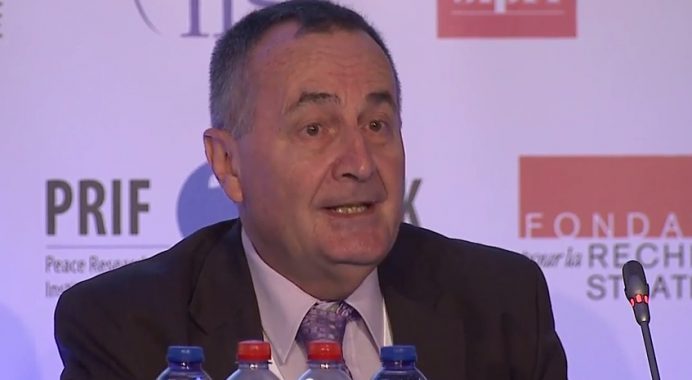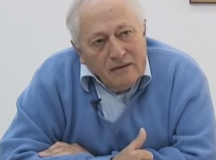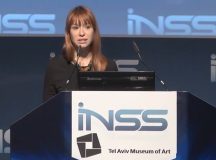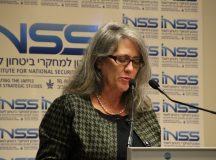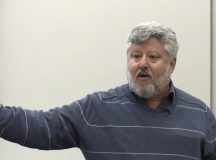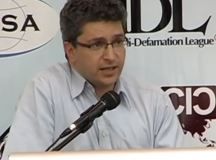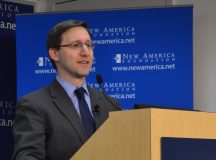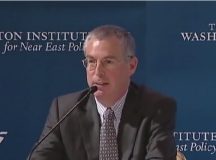Part 1
Part 2
Toby Greene: We have been interviewing a number of analysts over the last few weeks about how to bring a long-term change in the Gaza Strip. We have been asking them to respond to your paper, co-authored with Udi Dekel your colleague at the Institute for National Security Studies (INSS), which proposes an equation of ‘demilitarisation for reconstruction’.
Now a ceasefire has been declared, the big questions about the long term future of the Gaza Strip are yet to be addressed in negotiations. The question of demilitarisation is central to the Israeli and international discussion about Gaza; many of the respondents in our symposium have pointed out that it may be unrealistic in practice. Indeed, Israel has just agreed to allow material for reconstruction into the Gaza Strip without any commitment to demilitarisation on the other side. Can you clarify what you mean by demilitarisation and perhaps say what you think can be achieved realistically at this point?
Shlomo Brom: We relate to demilitarisation as a process, not as an item in the agreement with Hamas that can be achieved during negotiations for a long-term ceasefire. It was clear to us that it is not realistic to expect that Hamas will agree to disarm – we actually say this in the paper. What we meant is that we have to start a process that increases the long-term probability that the Gaza Strip will be demilitarised and the first stage is the prevention of rearmament.
We may say, a little bit cynically, that this long round of fighting caused Hamas to demilitarise themselves to a considerable extent – by losing the majority of their weapons systems.
TG: You spoke about an Arab League role in the future of the Gaza Strip, which some of the respondents to the symposium have picked up on. I think there is a shared understanding that certain Arab states share Israel’s interest in disarming Hamas. What is the practical role of Arab states including Egypt and Jordan in building the future of the Gaza Strip?
SB: We did not mean that all Arab League states will cooperate with our ideas. It is quite clear that Syria – the ally of Iran, Hezbollah and Islamic Jihad – is not going to cooperate in the demilitarisation of the Gaza Strip. But when you look at the current situation of the Arab League you can see that, practically, there are a number of states who form of a ‘coalition of the willing’ and who share the same interests. The main interest they share is in increasing the stability of the Middle East by a struggle against the destabilising forces: the so-called ‘Shiite Axis’ on the one hand and extreme Sunni Islamists on the other. We think that we can work with this coalition of the willing, which is formalised in the Follow-Up Committee on the Arab Peace Initiative which was established by the Arab League, and we think it is feasible to mobilise them for these purposes.
TG: What about the Palestinian Authority (PA) role? Do you think it is realistic that the PA can be reinstalled on Gaza’s borders? Will Hamas accept this, and will it make any difference, or will it just be the PA on the borders and Hamas in control behind the scenes?
SB: You have to look at this as a long-term process. Clearly Hamas will not give up its military control of the Gaza Strip soon, but one has to be open to the opportunities which have arisen, even before this round of violence.
Because of the deep crisis that Hamas is suffering and because it is disconnected from the few allies it had left (the only real allies of Hamas in the Middle East are Qatar and Turkey, who do not have access to the Gaza Strip), this provides a situation in which Hamas has no alternative but to yield gradually to the PA in different areas. In the Palestinian reconciliation agreement, Hamas decided to give up the civilian authorities in the Gaza Strip and let the Palestinian unity government control these authorities.
This is a good basis to start building a longer process which may lead to a full return of the PA to the Gaza Strip and to the constitution of a regime which is frequently described by President Abbas as ‘one authority, one gun’.
TG: If we think in practical terms about concrete and steel coming into the Gaza Strip, with the aim of helping reconstruct some of what has been damaged over the last few weeks, it appears that Hamas has the indigenous capabilities to produce rockets and dig tunnels with those raw materials. Is there any practical way of getting those materials in for reconstruction – which is in everyone’s interests – without them being diverted to Hamas for their own use?
SB: For the indigenous production of weapons they need dual use goods and machines. Practically, you can build a credible monitoring mechanism that will prevent – and I’m trying to be very accurate in describing it – large scale misuse of dual use materials and machines. I’m putting an emphasis on large scale because there is no monitoring mechanism that is perfect – there will be some leakage even with the best monitoring system. But there is a difference between the very limited capabilities of Hamas to self-produce these kinds of items in the Gaza Strip and large scale capabilities which is what we should aim to prevent.
TG: You spoke in your original paper about a UN Security Council resolution. Some respondents have noted that UN resolutions after similar conflicts in the past – such as those which followed the Second Lebanon War in 2006 and Operation Cast Lead in 2009 – have not had much impact. What should be in a UN resolution and what difference can it make?
SB: UN Security Council Resolution 1701 which ended the Second Lebanon War in 2006 prohibits the transfer of weapons into Lebanon to elements that are not legal elements of the Lebanese Government. This kind of wording can be even more helpful in the case of the Gaza Strip. In Lebanon, when this resolution was passed, it was quite clear that it could not be implemented: Syria shares a long border with Lebanon and because Syria was interested in transferring these weapons to Hezbollah there was no way of preventing it.
The reality in the Gaza Strip is completely different. Once there is such a resolution, it can be implemented, because of the full control of the borders of Gaza by Israel and Egypt. These two states share the interest of preventing the rearming of Hamas and other militant groups. So this time, I believe it is realistic to expect such a resolution will be implemented and such a resolution gives international legitimacy to what we want to take place in Gaza.
TG: The European Union has played an active role in the past with a Border Assistance Mission in Rafah on the Gaza-Egypt border, and it is offering to play an even more substantial role in future, whether that relates to borders or a sea port. Do you think the Europeans can play a positive role?
SB: I am certain that the EU can play a positive role. Looking at the experience of the last decade, usually the pattern is that the US leads the political process, mediates between the two parties and brings about agreements between them. But, the ones who usually implement these agreements when there is a need for third party intervention are the Europeans, so it looks probable that we will follow the same pattern.
The experience with the Europeans in these roles was usually positive, as long as the circumstances didn’t prevent their operation. That was the case with the European Border Assistance Mission at Rafah (EU-BAM). When Hamas took over the Gaza Strip they could not continue to operate and then the Rafah crossing stopped operating most of the time, because the Egyptians closed it. This threat will continue to exist, if Hamas will not allow the monitoring mechanism in these crossing, it will still be possible to close them.
TG: One specific proposal that has been floated is some kind of maritime channel from the Gaza Strip to Cyprus under special supervision. Do you think that is realistic?
SB: Yes, that is actually an idea that I was working on for a couple of years. It will not be possible to operate a sea port in Gaza – with international shipping coming in – without a credible monitoring mechanism. This mechanism should be outside the Gaza Strip because we cannot count on Hamas giving the monitors the full freedom they need to do their work. So it seems like a good idea to have a location – a sea port in Cyprus – to which every naval vessel that wants to enter the Gaza Strip will be checked, cleared and allowed to go to the Gaza port. I think Israel has the means to verify that nothing is put on board during this short sail between Cyprus and Gaza, so it can be a reliable mechanism.
TG: If the ceasefire holds within the next few weeks, Israeli and Palestinian delegations will travel to Cairo and negotiate, with Egyptian mediation, over the issues which remain outstanding. If you were part of the Israeli delegation travelling to Cairo in the coming weeks: what would be your negotiating principles, and what outcome you would be aiming for?
SB: I would try to free myself as much as possible from considerations of prestige or the ‘victory picture’ – this phrase is playing an important role in Israeli discourse; the feeling that Hamas must not be allowed to present a picture of victory. Hamas will present a picture of victory whatever we do, that is the nature of this conflict. As long as they exist and claim they fought until the last moment, they can present a picture of victory.
The real consideration should be: what are the necessary steps to assure the long-term stability of the ceasefire. In this military conflict, we dealt with one part of the deterrence equation – the threat of punishment. We proved to Hamas that we can punish them badly, now it is time to deal with the opposite side of the deterrence equation, which is motivation. If the motivation of the party you wish to deter is extremely high, then it will be almost impossible to deter it.
We have to take care of the motivation factor. That can be done by creating a situation in which Hamas and other groups will have a lot to lose if they start another armed conflict in Gaza. From my point of view, a sea port, maybe an airport, and economic reconstruction of the Gaza Strip can all be assets which will make Hamas calculate whether it is worth starting a new conflict with Israel and losing all these assets.
TG: One of the criticisms in the symposium is that this reflects a misreading of Hamas and their interests, representing them as having pragmatic goals, when in fact they are an organisation more concerned with their radical Islamist ideology and continuing its fight against Israel, and that those pragmatic incentives are not effective against them. How would you respond?
SB: I think that the biggest mistake is to take a very one-dimensional view of a political movement like Hamas. We use language that is pushing us towards this view by repeating the term ‘terrorist organisation’. Of course it is a terrorist organisation, but it is also a political and social movement. That is the difference between a movement like the Muslim Brotherhood – and Hamas is the Palestinian branch of the Muslim Brotherhood – and those crazy, Salafi, Jihadist groups like ISIS; they are not the same.
Hamas has very clear political aims and for these aims they must also be pragmatic. They may be very radical in their final aims, but they must be pragmatic in what they are doing in order to sell their objectives. I think that everyone who follows the conduct of Hamas since they decided to participate in the Palestinian elections in 2006, and even before, can see very clearly that there is this element of pragmatism which exists side-by-side with its extremism. As political movements do, they are looking for a compromise between the two.
TG: One of the criticisms from the centre and left in Israel of the government’s strategy has been the lack of a clear diplomatic end to the strategy or a political horizon. Prime Minister Netanyahu has hinted recently at the possibility of a broader diplomatic horizon, which might apply to the broader final status negotiations on the Palestinian issue. Do you have much optimism that we will see a diplomatic breakthrough?
SB: I must say that I agree with this criticism. We can do all these things that I am recommending, which will serve the purpose of a long-term ceasefire, but it will not be indefinite. As long as the conflict with the Palestinian continues, there will be outbreaks of violence during this conflict – sometimes in the Gaza Strip and sometimes in the West Bank. If we really want stability and normal relations with the Palestinians then we must have a political resolution of the conflict.
Here I am not optimistic. I think that the Israeli government – particularly Netanyahu – have gone through a tactical change in their thinking. Now they see the utility of the Palestinian unity government and will be willing to work with them to some extent. Now they see the re-entry of some PA elements into the Gaza Strip may be useful, but I don’t think that they have changed their basic concept, which is to continue with the status quo.
They do not believe that a permanent status agreement with the Palestinians is possible in their terms – the terms of the current Israeli government; but I think that these terms can and should be changed.
TG: There were many other responses to your paper in our symposium, are there any other elements you would like to respond to?
SB: To conclude I would say, we used the term ‘reconstruction for demilitarisation’ because it is a good catchphrase. In retrospect, it caused some misunderstanding. Too many people understood that what we mean is an immediate demilitarisation and that we think this is feasible. I hope that I clarified that this is not what we meant.

